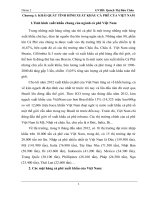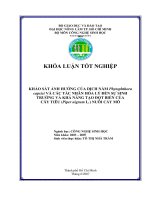btl hoá lý (bktphcm)
Bạn đang xem bản rút gọn của tài liệu. Xem và tải ngay bản đầy đủ của tài liệu tại đây (311.9 KB, 8 trang )
VIETNAM NATIONAL UNIVERSITY HO CHI MINH CITY
HO CHI MINH UNIVERSITY OF TECHNOLOGY
FACULTY OF CHEMICAL ENGINEERING
Ho Chi Minh city, May 1th 2022
HCMUT-Physical Chemistry
2
CC01-Group
3
TABLE OF CONTENTS
QUESTION 1.........................................................................................................................3
QUESTION 2.........................................................................................................................4
QUESTION 3.........................................................................................................................6
EVIDENCE OF TEAMWORK ACTIVITY
COMMENTS ABOUT THE PROJECT
This project is such a fantastic occasion for us to solve those tricky questions together,
which helps us strengthen our teamwork skills and prepare for a significant upcoming final
test. Therefore, we sincerely thank Prof. Long so much for creating this activity.
Page 2
HCMUT-Physical Chemistry
2
Assignment 1: State the thermodynamic aspects of the process of recovering a pure metal
from an aqueous solution containing Zn 2+ and Cu2+ metal ions (assuming the remaining ion
is only SO42-), including:
- Draw process diagrams
- Electrode selection
- Show the reactions on the electrodes
- Propose suitable DC voltage for the process (you can state other assumptions).
Solution
1. We have a process diagram as shown:
2. Electrode selection
-
It contains two compartments. One consists of a zinc strip dipping into a zinc sulfate
(ZnSO4) solution called the anode, and the other of a copper strip dipping into a copper
sulfate (CuSO4) solution called the cathode. A conducting bridge links both, it precludes
the mixing of the two electrolyte solutions, but it permits the current to pass from one to
the other. Moreover, both are in mutual electric contact through a metallic thread. One
galvanometer and an electric motor are inserted into the circuit. Finally, a millivoltmeter
is connected in parallel between the two lines.
-
Two kinds of electrical currents exist in the cell, called ionic current, it also exists in the
bridge.
Page 3
HCMUT-Physical Chemistry
23. The reactions on the electrodes
In anode:
Zn(s) Zn2+ + (w) + 2e- (metal) E0 = -0.76V
In cathode:
Cu2+ + (w) + 2e- (metal) Cu(s) E0 = 0.34V
Overall:
Zn + Cu2+ Cu + Zn2+
4. Suitable DC voltage for the process
E0cell = E0cathode – E0anode = 0.34 – (-0.76) = 1.1V
So DC voltage for the process should be around 1.1V
Assignment 2: A reaction, speeded up by one of its products, is called self-catalyzed. The
classic example of self-catalysis is a reaction of acetone iodination in an acid medium,
described by the total scheme:
The reaction consists of two stages. In its first stage, ketone transforms into enol (slowed
stage):
Further, enol reacts with iodide to form final products. As the reaction passes, hydronium
content increases, which speeds up the reaction. Thus, the rate of the reaction is defined by
the rate of acetone enolization:
Where CA is the current concentration of acetone, and k is a rate constant of the ratedetermining step. If initial concentrations of acetone and hydronium are marked as C A0 and
CB0, then kinetic equations of self-catalyzed reaction could be written in the form:
(x: the extent of the reaction = CA0- CA)
Page 4
HCMUT-Physical Chemistry
2
Given:
[CH3COCH3]0 = 0.2 M ; [I2]0 = 0.1 M
[H+]0 = 0.05 M
;
; k = 0.15 (M-1.h-1)
1. Plot the Concentration of CH3COCH2I as a function of time.
2. How long does it take to convert 80% of I 2?.
Solution
CH3COCH3 I 2 CH 3COCH 2I HI
Initial
CAo
0
Final
o
A
x
C x
From the information on the problem, we have:
dx (t)
=k (C A 0−x ( t ) )×(C B 0 + x (t ) )
dt
Convert it to the form x=f (t ):
dx (t )
=kdt
(C A 0−x ( t )) ×( C B 0+ x ( t ))
We integrate both sides:
x
t
dx (t)
∫ (C −x ( t ))×(C + x ( t ) )=∫ kdt( 1)
0
0
A0
B0
Suppose that:
1
A
B
=
+
= A ( C B 0+ x ( t )) +B ¿ ¿
( C A 0−x ( t ) ) × ( C B 0 + x ( t ) ) ( C A 0−x ( t ) ) ( C B 0 + x ( t ) )
¿
A C B 0+ B C A 0 + x (t )( A−B)
1
A−B=0
→
→ A=B=
C B 0 +C A 0
(C A 0−x ( t ))×(C B 0+ x ( t ))
A C B 0+ B C A 0=1
{
From the result of A and B, we convert (1):
x
∫
0
dx ( t )
( C A 0−x ( t ) ) × ( C B 0 + x (t ) )
x
¿∫
0
→
1
C B 0 +C A 0
+
1
C B 0+C A 0
( C A 0−x ( t ) ) ( C B 0 + x ( t ) )
dx ( t )=
1
C B 0+ C A 0
[
x
x
]
dx ( t )
dx ( t )
1
−ln ( C A 0−x ( t ) ) x +ln ( C
∫ C −x ( t ) +∫ C + x ( t ) =¿ C +C
0
) 0 ( B0
)
B0
A0
0 ( A0
[
C A0 (C B0+ x )
1
ln
=kt (2)
C B 0 +C A 0
C B 0 ( C A 0−x )
[
]
C B 0=¿ ¿
C A 0=[ C H 3 COC H 3 ]0 =0.2 ( M )
k =0.15( M −1 h−1 )
Replace C B 0, C A 0, k into (2) we have:
Page 5
HCMUT-Physical Chemistry
2
0.2 ( 0.05+ x )
1
ln
0.05+ 0.2
0.05 ( 0.2−x )
0.2 ( 0.05+ x )
1
ln
=0.15t →
=t
0.05+0.2
0.15
0.05 ( 0.2− x )
[
[
]
]
Suppose:
0.2 ( 0.05+ x )
1
ln
0.05+ 0.2
0.05 ( 0.2−x )
=f ( x )
0.15
[
]
Time (h)
Using Casio calculator to solve equation f ( x )=tthen using excel to plot the diagram:
50
45
40
35
30
25
20
15
10
5
0
0
0.01 0.02 0.03 0.04 0.05 0.06 0.07 0.08 0.09 0.1
[CH3COCH2I] (mol/L)
To reduce 80% of I2, we need: x=C A 0−C A =C(I ¿¿2)0−C
t=
C A 0(C B0+ x )
1
ln
C B 0 +C A 0
C B 0 ( C A 0−x )
[
k
]
(I ¿¿2)=0.8× 0.1=0.08 ¿
¿
0.2 ( 0.05+0.08 )
1
ln
0.05+ 0.2
0.05 ( 0.2−0.08 )
=
=39.102( h)
0.15
[
]
Assignment 3: Reaction A + 3B C has first order for each reactant with the rate constant
k2=0.15M-1.min-1. Plot the concentration of A, B, and C as a function of reaction time until 90%
of B is converted. Given: [A]0=0.5M, [B]0=0.6M.
Equation:
A
t=0:
[A]0
Reacted:
x
t=t:
[A]0-x
+
[A]0=0.5M; [B]0=0.6M ;
3B
C
[B]0
3x
[B]0-3x
x
x
k2 0.15M 1.min 1
Page 6
HCMUT-Physical Chemistry
2
90% B 0 90% 0.6 0.54 M
90% of [B]0 is converted at t=t:
Let x be the concentration of specie A reacted at the time t . 3x is the concentration of
specie B converted at a time t . 3x 0.54 x 0.18
[A] A 0 x A 0
B 0 [B]
3
B B 0 3x B 0 3( A 0 [A])
The expression of rate law:
R
dA
1
1
k[ A][B ]
d [A] dt
d [A] dt
dt
k[ A][B ]
0.15 [A] [B]0 3 [A] 0 [A]
1
1
∫
d [A] ∫
d [A]
0.15 [A] (0.6 3 (0.5 [A])
0.15 [A] [B]0 3 [A] 0 [A]
20
200
1
∫
d [A]
d [A]
∫
9
[A] (5 (2[A] 1) 2)
3
1
3 [A] 3 [A]
2
5
1
Solving ∫
d [A]
[A] (5 (2[A] 1) 2)
du
1
1
10
Substituteu
5(2[A] 1) 2
10 d [A] du , use :
d [A]
10
[A] u 3
1
1
∫
du ∫
du
3
u (u 3)
2
u ( 1)
u
3
dv 3
u2
Substitute v 1
2 du
dv :
u
du u
3
3
ln
1
1 1
1
5 (2[A] 1) 2
∫ dv ln(v )
3 v
3
3
3
200 ln
1
200 (ln | 10 [A] 3 | ln [A] )
5 (2[ A] 1) 2
200
1
d [A]
C
C
∫
9
[A] (5 (2[A] 1) 2)
27
27
1
∫0.15 [A] (0.6 3 (0.5 [A]) d[A] ∫dt
200 (ln | 10 [A] 3 | ln [A] )
27
C
t 0 [A] 0.5M
200 (ln | 10 0.5 3 | ln 0.5 )
C t t0 0 C 10.2688
27
200 (ln | 10 [A] 3 | ln [A] )
1
∫
d [A]
10.2688 t
0.15 [A] (0.6 3 (0.5 [A])
27
Page 7
HCMUT-Physical Chemistry
2
200 (ln | 10 [A] 3 | ln [A] )
10.2688 t
27
The equation for [A]:
When 90% of [B]0 is converted:
[A]t [A]0 x 0.5 0.18 0.32 M t 13.75 min
Similar for [B] and [C] equation:
dB
1
3k[ A][B]
d [B] dt
dt
3k [ A][B ]
1
d [B] dt
[B] 0 [B]
3 0.15 [B] [A]0
3
R
1
∫
[B]0 [B]
3 0.15 [B] [A]0
3
200 ln 10 [ B] 9 ln [B ]
1
∫
[B] 0 [B]
3 0.15 [B] [A]0
3
d [B] ∫dt
1
d [B] ∫dt
0.6 [B]
3 0.15 [B] 0.5
3
d [B] ∫
C t
27
t 0 [B] 0.6 M C 23.8435
The equation for B:
200 ln 10 [ B] 9 ln [B]
27
dC
1
k[ A][B ]
d [C] dt
dt
k[ A][B ]
1
d [C] dt
0.15 0.5 [C ] 0.6 3[C ]
23.8435 t
R
200 ln 5 [C ] 1 ln 2[C ] 1
27
t 0 [C ] 0 M C 0
The equation for C:
Concentration (M)
1
∫0.15 0.5 [C ] 0.6 3[C ] d [C] ∫dt
C t
200 ln 5 [C ] 1 ln 2[C ] 1
27
0 t
Plot the concentration of A, B, C following the equations:
Concentration of A
Concentration of B
Concentration of C
t (min)
Figure: Concentration of A, B, C as a function of reaction time
Page 8







